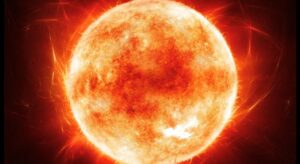A global team of solar scientists, including researchers from the Indian Institute of Astrophysics (IIA), has successfully mapped the dynamic plasma currents in the Sun’s Near-Surface Shear Layer (NSSL), uncovering patterns that align with the Sun’s 11-year magnetic activity cycle, commonly known as the sunspot cycle.

About the Near-Surface Shear Layer (NSSL) & Key Discoveries
- The Near-Surface Shear Layer (NSSL) is a vital region just beneath the Sun’s visible surface, extending roughly 35,000 km deep.
- In the NSSL, the Sun’s rotation speed decreases significantly with radius, creating a shear effect that varies across different depths, latitudes, and solar magnetic activity.
- The study revealed that plasma flows on the surface tend to converge towards sunspot latitudes, but they reverse direction partway through the NSSL and flow outward, forming large-scale circulation cells.
- These flows are influenced by the Sun’s rotation and the Coriolis effect, which also impacts phenomena such as hurricanes on Earth. This relationship helps to clarify how the Sun’s rotation behavior changes at different depths.
- Despite their dynamic nature, these localized plasma flows do not drive the Sun’s large-scale zonal flows, known as torsional oscillations, suggesting the presence of unknown forces deeper within the Sun’s interior.
Techniques Employed
- The researchers used helioseismology, a technique that relies on sound waves traveling through the Sun to map its internal structures and dynamics.
- Data from over a decade, gathered from:
- NASA’s Solar Dynamics Observatory (SDO), particularly the Helioseismic and Magnetic Imager (HMI), and
- The Global Oscillations Network Group (GONG) from the National Solar Observatory (NSO) in the USA, were used to confirm the findings.
- The study also included 3D velocity maps of sunspot regions, which demonstrated the correlation between surface inflows and deeper outflows.




